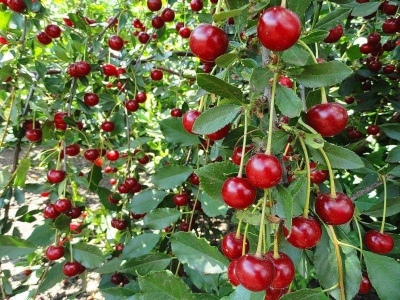
- Authors: H.K. Enikeev, S.N. Satarova, A.I. Evstratov, A.M. Mikheev, V.S. Simonov (All-Russian Institute of Selection and Technology of Horticulture and Nursery)
- Year of approval: 2001
- Barrel type: wood
- Growth type: medium-sized
- Crown: round, compact, raised, medium density
- Escapes: straight, brown, with a medium number of lentils, vertical direction of growth
- Leaves: medium, obovate, concave, dark green, matte, wrinkled, no pubescence
- Flowers: small, saucer, white
- Flowering and fruiting type: on bouquet branches
- Fruit size: average
Cherry Bulatnikovskaya is a variety bred by specialists from the All-Russian Institute of Selection and Technology of Horticulture and Nursery. It has been approved for use since 2001 and is intended for universal use.
Description of the variety
The presented variety is characterized by the following external features:
the tree has an average vigor of growth, reaches a height of 2.5-3 m;
the crown is round, compact, of medium density;
shoots are brown, grow vertically, have an average number of lentils;
leaves are dark green, slightly rough, wrinkled, the leaf plate is smooth, obovate;
flowers are small, white in color, formed in the form of a saucer, 4-6 flowers are formed in one inflorescence, fruiting is observed on bouquet branches.
Fruit characteristics
The berries are medium in size, their weight is about 3.2 g, the shape is round, but somewhat flattened. Covered with a dark red skin, under which a red dense flesh is hidden.
Taste qualities
The fruit tastes sweet and sour, estimated at 3.9 points. The pulp contains a sufficient amount of dry matter and ascorbic acid. The bone is small inside. This variety is suitable for fresh consumption and for making jam or compote, but it is better not to use this variety as a filling for pies, since the bone is hardly separated from the pulp, which complicates the cooking process.
Ripening and fruiting
The presented variety bears the first fruits already 3-4 years after planting. Refers to varieties with an average ripening period. The ripening of the berries is somewhat extended, since they do not reach ripeness at the same time.

Yield
It is a high-yielding variety, capable of producing an average of 10-12 kg of berries per tree.
Landing
This variety does not tolerate excess moisture well, therefore, an area with a high level of groundwater is not suitable for cultivation, they should be located at a depth of at least 3-4 m from the surface. And also it should be a well-lit place, closed from drafts. The planting process is as follows.
In the fall, prepare the site: dig it up and add humus.
After two weeks, dig a 70x90 cm planting hole.
The planting itself is carried out in the spring. Fill the bottom with a drainage layer.
Set up a support, plant a seedling and tie it up.
Fill the hole so that the root collar remains on the surface.
Compact the planting site and water abundantly.


Growing and care
Bulatnikovskaya cherry cannot boast of good indicators of winter hardiness and heat resistance, therefore, the variety is recommended for cultivation in the central regions of Russia. Gardeners provide some tips for tree care.
Water as the topsoil dries. At first, the seedling needs watering 1-2 times a week, gradually the amount of irrigation is reduced, but the volume of water is increased. To keep moisture as long as possible, loosen the soil and mulch the trunk circle.
The manufacturer claims that this variety does not need pruning, but note that we are talking about shaping pruning. Sanitary measures must be carried out without fail. As a rule, they consist in the removal of diseased, dry, frozen branches.
It is a self-fertile variety, so there is no need to plant a tree nearby to act as a pollinator.


Disease and pest resistance
The tree of the presented variety is almost not affected by coccomycosis, but it can become a victim of moniliosis. Bushes with signs of the disease should be treated with Bordeaux liquid or a solution of "Horus", "Cytoflavin" or "Fitosporin-M". In order to prevent the occurrence of an ailment, take preventive measures:
when pruning, process all cuts with garden pitch;
after leaf fall, cover the trunk with whitewash;
remove the carrion in a timely manner;
spray trees with copper sulfate.
































































